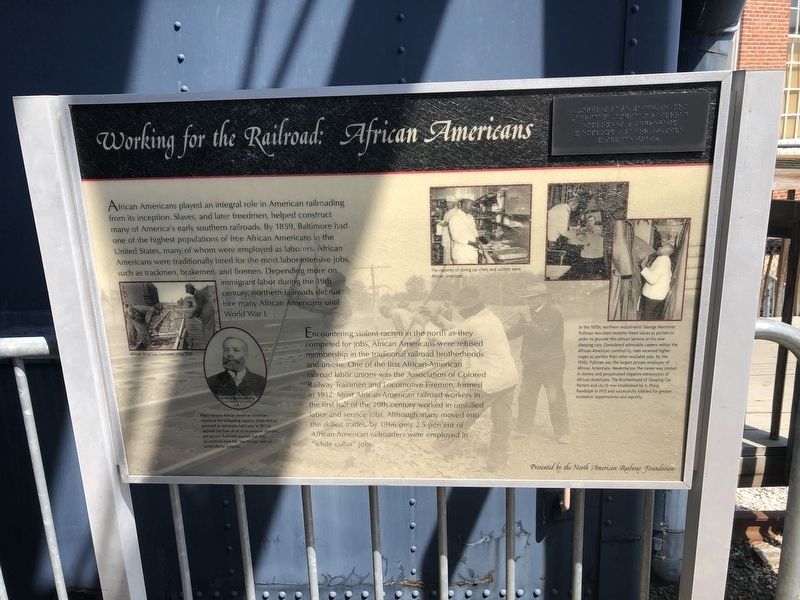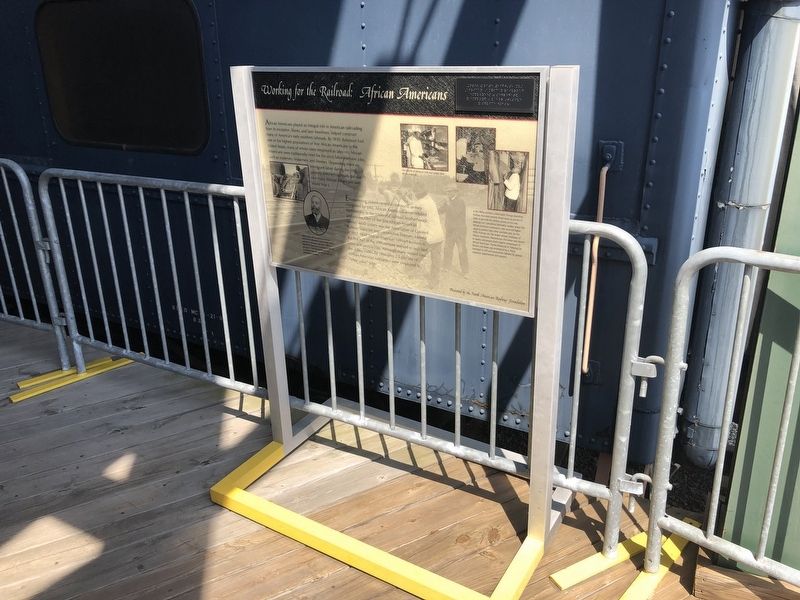Pigtown in Baltimore, Maryland — The American Northeast (Mid-Atlantic)
Working for the Railroad: African Americans

Photographed By Devry Becker Jones (CC0), June 29, 2019
1. Working for the Railroad: African Americans Marker
African Americans played an integral role in American railroading from its inception. Slaves, and later freedmen, helped construct many of America's early southern railroads. By 1859, Baltimore had one of the highest populations of free African Americans in the United States, many of whom were employed as laborers. African Americans were traditionally hired for the most labor-intensive jobs such as trackmen, brakemen, and firemen. Depending more on immigrant labor during the 19th century, northern railroads did not hire many African Americans until World War I.
Encountering violent racism in the north as they competed for jobs, African Americans were refused membership in the traditional railroad brotherhoods and unions. One of the first African-American railroad labor unions was the Association of Colored Railway Trainmen and Locomotive Firemen, formed in 1912. Most African-American railroad workers in the first half of the 20th century worked in unskilled labor and service jobs. Although many moved into the skilled trades, by 1966 only 2.5 percent of African-American railroaders were employed in "white collar" jobs.
[Captions:]
African-American trackmen, circa 1930.
Many notable African-American inventors improved the railroading industry. Elijah McCoy patented an automatic lubricator in 1872 to regulate the flow of oil to locomotive cylinders and pistons. Railroads insisted that their locomotives have the "real McCoy" and not some inferior imitation.
The majority of dining car chefs and waiters were African American.
In the 1870s, northern industrialist George Mortimer Pullman recruited recently freed slaves as porters in order to provide the utmost service on his new sleeping cars. Considered admirable careers within the African-American community, men received higher wages as porters than other available jobs. By the 1920s, Pullman was the largest private employer of African Americans. Nevertheless the career was rooted in slavery and perpetuated negative stereotypes of African Americans. The Brotherhood of Sleeping Car Porters and Maids was established by A. Philip Randolph in 1925 and successfully lobbied for greater economic opportunities and equality.
Erected by The North American Railway Foundation.
Topics. This historical marker is listed in these topic lists: African Americans • Labor Unions • Railroads & Streetcars. A significant historical year for this entry is 1959.
Location. Marker has been permanently removed. It was located near 39° 17.098′ N, 76° 37.96′ W. Marker was in

Photographed By Devry Becker Jones (CC0), June 29, 2019
2. Working for the Railroad: African Americans Marker
We have been informed that this sign or monument is no longer there and will not be replaced. This page is an archival view of what was.
Other nearby markers. At least 8 other markers are within walking distance of this location. Luther G. Smith (a few steps from this marker); Pullman Troop Sleeper No. 7437 (within shouting distance of this marker); Connectivity: Street Art at the Intersection of Rail, Community, & Identity (within shouting distance of this marker); B&O Railroad Museum (within shouting distance of this marker); Main Line Electrification of the Baltimore and Ohio Railroad (B&O) 1895 (within shouting distance of this marker); CSX Corporation (within shouting distance of this marker); The National Road (within shouting distance of this marker); The Underground Railroad (about 300 feet away, measured in a direct line). Touch for a list and map of all markers in Baltimore.
Credits. This page was last revised on March 23, 2024. It was originally submitted on June 29, 2019, by Devry Becker Jones of Washington, District of Columbia. This page has been viewed 397 times since then and 57 times this year. Photos: 1, 2. submitted on June 29, 2019, by Devry Becker Jones of Washington, District of Columbia.